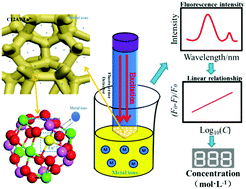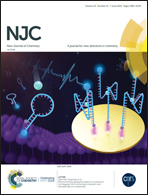Synthesis and characterization of macroporous europium-doped Ca12Al14O33 (C12A7:Eu3+) and its application in metal ion detection†
Abstract
Macroporous europium-doped Ca12Al14O33 (C12A7:Eu3+) was prepared via a sol–gel method followed by heat-treatment, and the crystal structure, luminescence performance and metal ion luminescence sensing of C12A7:Eu3+ were investigated and evaluated in detail. The process of the sol–gel method and heat-treatment promotes the formation of a single mayenite phase C12A7:Eu3+, and the Eu3+ ions are incorporated into the crystal lattice and replace the position of the Ca2+ ions without destroying the lattice structure of C12A7. The interconnected macropores not only increase the lighting area but also reduce the concentration quenching effect, leading to a significant enhance of luminescence intensity. The resultant macroporous C12A7:Eu3+ can be used as a luminescence performance sensor and displays the potential practical application for metal ion detection. The macroporous C12A7:Eu3+ sensor has a good response to Pb2+ ions, whose linear equation between concentration (CPb) and luminescence intensity (F) of (F0 − F)/F0 = 1.412 + 0.3428 log10(CPb) can be obtained.



 Please wait while we load your content...
Please wait while we load your content...